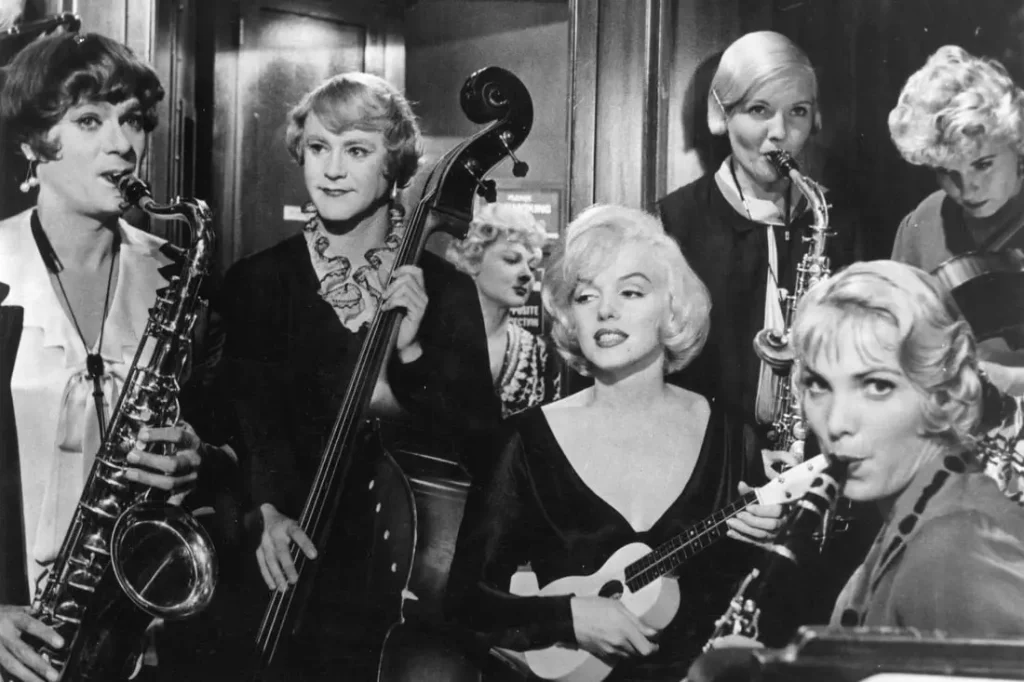
There are films that make you lose count of how many times you’ve seen them. Some Like It Hot is one such film, and its appeal goes beyond simply being a comedy. Its lasting charm comes from how it effectively combines Hollywood filmmaking techniques, good storytelling, and the skill of its actors to deliver strong performances. Even those watching for the first time can sense director Billy Wilder’s dedication to upholding the essence of Hollywood-style comedy.
When it was first released, the film was very well-received by audiences and critics, and it competed for awards alongside Ben-Hur. While it didn't win many major trophies, it did receive an award for Best Costume Design.
In this analysis, I aim to explore why this enduring classic remains enjoyable even after many viewings, and how its appeal is carefully constructed.
Wilder's Intended Narrative Structure
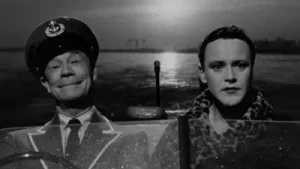
The story can be divided into three main acts, and each one starts with a shot of someone's feet. Act One opens with Spats' feet stepping out in a Chicago parking garage. While the story begins earlier in a speakeasy, this scene is where Joe and Jerry, who are being pursued, first encounter Spats and his gang.
Act Two begins with Joe and Jerry, now disguised as Josephine and Daphne, walking toward a train bound for Florida. The camera captures their feet, awkwardly navigating in high heels, from behind. Just before this, Joe had made a call to a talent agency using a falsetto voice. The shot then smoothly transitions from a close-up of their faces to their walking figures from behind, then to an upper body shot showing their female disguises.
All scenes of them changing into women's clothing or applying makeup are omitted. This clever editing creates a rhythm for the story, building a sense of anticipation for what's to come. By immediately showing them transformed into women, the film not only saves time and compresses the narrative but also introduces humor, a key element of this work. It's the moment the suspenseful tone abruptly shifts to comedy.
Act Three takes us to Florida. Spats reappears, once again from a shot of his feet, as he attends an opera lovers' convention. The suspenseful tone returns, adding another layer to the comedy.
In the Writers Guild Foundation's video, "The Writer Speaks," Wilder compared a screenplay to a house. He explained that just as walls and pillars rest on a foundation, the strength of a film's second act, following the first, is crucial. He built the story using the idea of men in disguise as women as its foundation, then added elements of suspense and comedy on top.
This analysis, which divides the film into three acts based on the foot-level scenes, appears consistent with the director's vision.
The feet that structure the story are not merely body parts.
From here, let's take a closer look at the role feet play as a compositional element.
Male Feet, Female Feet
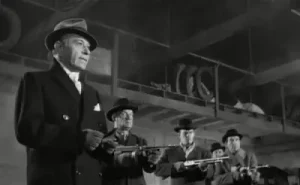
When considering male feet, the first example is the feet of the mafia boss. His feet are strictly protected by spats, just like his name. The purpose of spats is to protect shoes from dirt or small stones. While they also offer warmth, given the boss's stylish and meticulous nature, the former is more likely. He never goes without his spats, even in tropical Florida.
His starched white spats have no color, as if to avoid mixing with others, and they feel somewhat weighty. Their horizontally spreading lines lead the eye to the four men surrounding him. These strong men are highly educated lawyers, protecting the boss with both their physical strength and intellect.
Another example of male feet appears in this film. But before that, I'd like to write about female feet. It's easier to grasp the story's structure by first understanding the symbolic meaning of feet based on gender differences.
There's no doubt that female feet here refer to Marilyn Monroe's. Joe and Jerry, disguised as women, were captivated by Sugar's feet in heels. Beyond being an object of desire, Jerry is surprised by how effortlessly she walks, despite him stumbling in unfamiliar heels, and by her quick movements to dodge the train's steam.
Jerry is simply amazed by Sugar as a woman. He's surprised not only that she's different from them as men, but also that she's a different kind of woman altogether—unlike bar dancers or talent agency clerks who are merely accessories to men. He'd never known such a being existed.
She lightly taps her heels, walking rhythmically with slender, extended legs. Her way of walking conveys a sense of dynamism, and even a resolve to move towards her goal. It's as if she's showing that difficulties are nothing to her. There's a sense of freedom in her back.
A completely new concept, embodied by Sugar's physique, determined the direction of the story.
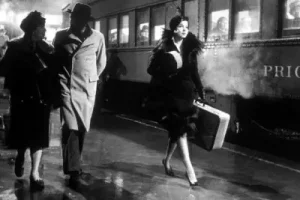
Sugar, who is concerned about the straightness of her stocking seams, conveys a beauty meant to be seen, but also a human will to ascend. This also relates to the life of a performer, a singer. She doesn't lament her lack of education and sometimes even lies to make herself look better.
However, Sugar's feet, encased in thin, translucent stockings that accentuate female beauty and elevated by slender heels, are both exposed and vulnerable, without anything to protect them. Yet, she fully understands that this is the price of freedom.
Just as she hides mini bottles of whiskey, it's also a secret place. Sugar carries human desires from the Prohibition era, like alcohol, hidden beneath her outward feminine facade.
Caught between male and female are Joe and Jerry, who disguise themselves as women to escape the male world. They notice Sugar, this new kind of being. As men, they fall in love with a woman, while as women, they flee from men. The story unfolds with two developments centered on feet.
Male Feet for Men
Male feet, for men, are a bit complicated, but this is a story about men in disguise as women. First, feet constantly trouble men. Spats is annoyed when whiskey spills on his spats, Daphne, in disguise, twists her ankle in high heels, and the millionaire Osgood is captivated by her feet in Florida.
Second, feet act as a trigger for men to take action. Joe and Jerry rush to the train, chasing Sugar. In Florida, they disguise themselves as a wheelchair-bound guest and a hotel bellhop, but they forget to take off their high heels and are discovered by the mafia henchmen.
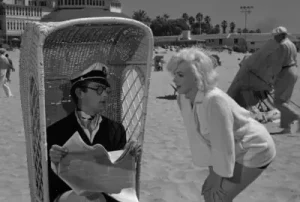
Feet don't bring about good situations for men. However, the last point is different: feet become a decisive weapon to strike an opponent's weak spot.
This refers to the scene where Joe, disguised as the millionaire Junior, intentionally puts out his foot, causing Sugar to trip. His foot provided significant help to him and determined Sugar's fate.
Joe deliberately put out his foot, and Sugar fell by neatly getting caught in the trap, almost jumping as she fell. This is the only scene where feet became a powerful weapon for a man.
Male Smiles and Expressionless Faces
If feet relate to a man's fundamental aspects like life and destiny, then the face, being furthest from the feet, connects to a man's desires and rationality. A typical example is the wide-open laughing face of the millionaire Osgood. Osgood falls in love with Daphne at first sight, making a primal, instinctive face like a monkey in heat. Joe E. Brown, a seasoned performer, could make audiences laugh just by appearing on screen; his facial structure itself serves as a model for a comedian who elicits laughter.
However, Osgood isn't the only one who displays an animalistic face. On the train to Florida, Jerry, in disguise as a woman, confides in Joe his desire to win Sugar's affection. But his wide-open mouth expresses male instinct more honestly than his confession.
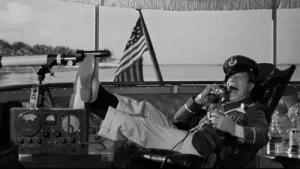
If a smiling face represents a man's instinct, then the opposite, an expressionless face, signifies self-restraining rationality. Spats' face, showing no emotion to detectives or his boss, is a calculated act of self-preservation. Joe's expressionless face, disguised as the millionaire Junior, is attributed to the trauma of his girlfriend's death. This, too, is a calculated move.
A man's laughing face is a primitive instinct displaying sexual desire, while an expressionless face is a rational act, done deliberately.
By the way, is it merely a coincidence that Osgood, Spats, and the hotel porter trying to flirt with Josephine are all small in stature? Personally, I don't think so.
Male and Female Names
A trio of two men and one woman is a classic setup for a romance story, but we can find insights into their naming from their roles.
Jerry was named Geraldine by Joe but changed it to Daphne himself. In Greek mythology, Daphne is the name of a nymph who transformed into a laurel tree to escape Apollo. In this film, Daphne is fleeing from the millionaire Osgood. The name also relates to the "Daphne complex," which signifies adolescent or virginal same-sex affection, purity, and male phobia.
Josephine is a variation of Joe's name; Napoleon's wife comes to mind from history, but it's questionable whether that's relevant to this film.
Sugar is a sweet cake itself. Her body is sweet prey for men, but in reality, she longs for childhood games with her sister and fleeting romances. She's pure, but perhaps also delusional.
Both Joe and Jerry are captivated by this sweetness. Even Spats succumbs. He was shot by a killer hidden in a fake cake, a block of sugar.
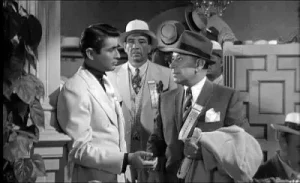
As an aside, the hitman Johnny is the son of Edward G. Robinson, who co-starred with George Raft (who played Spats) many times. The actor, named Junior after his father, died young without achieving much prominence in Hollywood. The name Junior is the same as that of the fake millionaire who inherits his ancestor's name, but this might just be a coincidence.
Charles Lang's Cinematography, Orry-Kelly's Costumes
This film feels perfectly complete at the script stage. However, there's another element we shouldn't overlook: the joy of watching the leading lady, Marilyn Monroe.
To put it simply, the staff used every technique imaginable to make Marilyn Monroe look captivating, and they succeeded. The audience is captivated by the result—that's the joy of watching Some Like It Hot. Director Wilder, who compared a story to a house, truly brought the third act to vibrant life, making it shine as a star.
Cinematographer Charles Lang filmed Monroe in a way that made her stand out from the background, giving her a sublime, goddess-like quality. When she sings on stage, he bathes her in intense light glowing from the darkness, and in other scenes, he avoids casting shadows on her face. Even at night, he brightens the background.

Orry-Kelly's costumes seem to flow over Monroe's body. The transition from the heavy black coat in Chicago to the light white dress in Florida also conveys a sense of emotional liberation.
The sparkling black dress with frills and sequins on stage represents the countless dreams she's held since childhood. While expressing such innocence, the costume also accentuates her figure in the darkness, making her more suggestive than if she were nude. The costume department won the film's only Academy Award, perhaps because of how beautifully it adorned Monroe.
The reason she's still considered a sex symbol today is likely due to her singing scenes in this film and the skirt-blowing scene in The Seven Year Itch. The latter is healthy, but the former, with her fuller figure, highlights a more sensual aspect.
Background Sets Expressing Sugar's Heart
Just as the cinematography and costumes effectively highlight Monroe's outward charm, we cannot overlook the background sets that convey Sugar Kane's feelings and personality.
On the train to Florida, Sugar confesses to having played in several bands. In the background, light streaks quickly across the train window. It's likely from utility poles, but it looks like twinkling lights or shooting stars, suggesting past heartbreaks.
Sugar runs towards the pier where the fake millionaire Junior awaits, her heart fluttering with the start of a new romance. It should be late night after the show, but in the bust shot of her, there's no darkness in the background.
Just before this, Joe passes Daphne and Osgood III on a bicycle, and the surroundings are pitch black. Yet, in Sugar's very next shot, the darkness has vanished from the background, replaced by an artificial, vaguely diffused brightness.
When filming Monroe's face without shadows in the darkness, it inevitably looks unnatural. So, for this scene, they likely prioritized a screen tone that matched Sugar's feelings of longing for love.
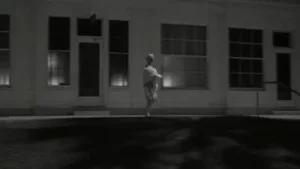
A scene follows where the background set most vividly expresses Sugar's feelings as she runs towards the pier.
Sugar arrives in front of a row of buildings along the sandy beach. The first floor seems to be a clothing store, with high-ceilinged, glass display windows. Sugar runs past them. The unadorned, dark display windows have several lights left on in the ceiling. As Monroe's body momentarily blocks the lights while she runs, they appear to flash as she moves forward.
On the train, the lights just flowed past her in the background, unrelated to her movement. But in this scene, Sugar herself is moving and giving life to the lights. Their flickering can almost be felt as her heartbeat.
The camera captures Sugar as she reaches the pier, shot from amidst the waves. The background appears generally bright, almost like a studio set, but a figure seems to be moving in the far right background, so that might not entirely be the case. It could have been incidentally captured during location shooting.
At any rate, this bright background, despite it being midnight, is clearly to show Marilyn Monroe's full figure.
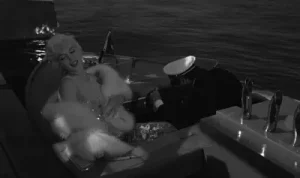
However, the next scene has a nocturnal feel. Shadows of moonlight, leaking through gaps in pillars, fall on the fur stole Sugar wears while on a boat.
There are actual stills from the shooting, and the sky isn't dark. It might have been filmed using the "American night" technique. A documentary released in 2001 also shows the filming appearing as if it were daytime. Of course, it might just be color added to black-and-white footage, so nothing is certain.
The scene from when Sugar finishes her stage performance until she gets on the boat is only a few tens of seconds long. Yet, through Monroe's performance and the crew's technical skill, it fully showcases her charm, perhaps even more than the singing scenes.
Music: The Fourth Protagonist
Film music is sometimes called the hidden protagonist because it foreshadows the story's development, hints at characters' psychological states, and elevates scenes.
The music for this film, composed by Adolph Deutsch, who scored multiple films annually from the late 1930s to the 1960s, announces its presence from the very beginning as if declaring itself a protagonist.
Comedy films of the 1930s typically began with a rhythm that characterized the work during the opening credits and concluded with an upbeat melody for the ending. Trouble in Paradise, Bringing Up Baby, and It Happened One Night are classic examples.
But the music in Some Like It Hot doesn't just enhance the film. It proudly asserts itself as the fourth main character alongside the three leads.
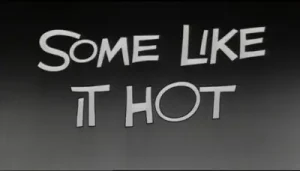
In the opening, Marilyn Monroe, Tony Curtis, and Jack Lemmon's names appear with three trumpet sounds, and then the film's title appears with the fourth. The lively rhythm of "Runnin' Wild" plays as the credits finish, and finally, three bells ring. These symbolize the three main characters.
Here, the music suddenly drops from an uptempo to a low register, as if taking a breath. This abrupt change helps audiences settle in and smoothly enter the story.
Music flows throughout the film, strengthening the atmosphere. Its appearance milliseconds before characters to depict their psychology and foreshadow story developments is a classic Hollywood musical technique.
The music, which characterizes the film with its opening rhythm and symbolizes the characters with bell sounds, asserts its own presence at the ending.
The story concludes with the millionaire saying, "Nobody's perfect," followed by a staccato trumpet rhythm, and then "Runnin' Wild" plays again. Finally, the bells ring three times, and the film ends with a grand orchestral crescendo.
The three bell sounds, like at the beginning, symbolize the three main characters. So what could the fourth represent? Considering the story's conclusion, church bells might come to mind.
A church is a place where vows of love are made, and marriage is the culmination of a man and woman's romance. Two people bound by love marry, and the bells of blessing ring. The grand crescendo further heightens their happiness.
What shouldn't be overlooked is that there's no credit roll at the end; only music plays against a black screen. This brief, pleasant afterglow makes the story's ending feel personal. The intention to leave the audience feeling good about the film's conclusion aligns with Director Wilder's philosophy.
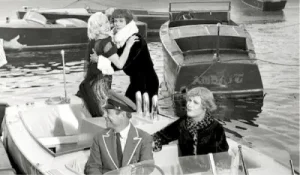
Thus, the music sometimes depicts psychological states before the characters do, and other times asserts a presence equal to or greater than the main characters. However, it concedes its place in one instance. That's the scene where Sugar climbs the pier stairs, chasing Joe and Daphne, who are on the millionaire's boat, trying to escape the mafia.
Sugar's breathless feelings are entirely different from the first time she met the fake millionaire. She runs up the stairs not for money or a luxurious life, but to grasp the love she truly desired. Her foot movements are even faster than the small, quick rhythm of the music. This is because the film's frame rate was increased during editing.
The staff used a different technique than the first time to express her lovelorn heart. Her emotions and actions dramatically connect in a cinematic way, making it the most impactful scene. And these two pier scenes are also full of Marilyn Monroe's endearing charm.
Monroe's Three Songs
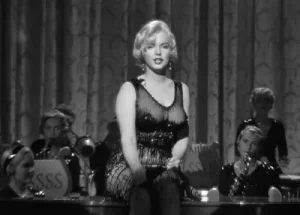
Monroe sings three songs in the film: "Runnin' Wild" on the train, and "I Wanna Be Loved by You" and "I'm Thru With Love" on stage in Florida. All are filled with her exuberance and allure, seemingly composed specifically for this film, but that's not the case. They were originally released in 1922, 1928, and 1931 respectively, and were well-known songs.
However, they were typically sung with a pastoral melody at the time. Yet, as soon as Monroe began to sing them, they seemed to gain vitality, became more sensual, and plunged into sorrow. Of course, the power of the visuals played a role, but in addition to the arranger's work, Monroe's interpretation and delivery of the songs were simply superb. She redefined their image, making her versions definitive and unique.
Monroe's appearance when singing is distinctly different from the other women. The talent agency secretary and the bandleader, though having well-defined features, are deliberately played as unattractive with heavy makeup and formulaic speech. The band members, too, appear thin and frail, with bony cheeks and pointed, triangular chins.
In contrast, Monroe's full upper body and round face, surrounded by these women, shine like the sun, drawing those around her in like planets. The audience cannot tear their eyes away from this captivating presence.
The Culmination of Screwball Comedy
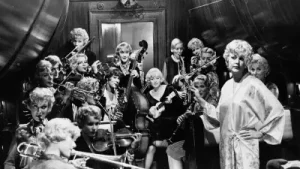
Some Like It Hot gives the impression of a film made in the 1930s, going back in time, with its story structure, character relationships, delicate work by the production staff in cinematography and lighting, music that embodies a personality, and good-looking actors.
The reason for making it a black-and-white film was supposedly to avoid making Tony Curtis and Jack Lemmon look unattractive in drag, but one might suspect that a nostalgia for screwball comedies was the true reason.
Around this time, film noir and socially conscious works were beginning to stand out, and the emergence of New Hollywood cinema was near. In such a climate, one might wonder if Director Wilder consciously aimed to create the final screwball comedy. If so, it would not be an overstatement to call it the culmination of screwball comedy.
Finally, though unrelated to the film itself, in Japan, Some Like It Hot is considered Marilyn Monroe's film and, for some reason, believed to be a work for adults. It's almost never screened in cinemas.
However, worldwide, it's viewed as a historical masterpiece by a wide range of generations. In France, it's said to be a film that children, in particular, should see. In fact, while traveling in France, I watched it at a cinema in Dunkirk with elementary school students led by their teacher, and everyone was laughing heartily. This made me ponder if this is the difference in cultural awareness between Japan and the West.
Watching films without being bound by generation or era. It seems there's an underlying awareness to evaluate a work's value fairly, regardless of its topicality, and to pass it down as an art piece.
This film was originally based on a German film from the 1930s about men in drag, incorporating the Prohibition era and gangsters, and then meticulously crafted as a comedy.
There are no scenes that can be dismissed as unnecessary. Not only the main actors but also the supporting cast bring their characters to life with fitting lines and gestures. The film is almost too perfectly made. Because of this, some contemporary viewers might find it constraining.
However, there's no doubt that this film is the pinnacle of comedy cinema.
To create something that entertains people, mere temporary expressions like momentum or a fleeting trend won't stand the test of time. And if a director's unique vision isn't at the foundation of a work, it won't lead to universality. Some Like It Hot will continue to live on as proof of this.
Originally written in Japanese and translated using Gemini AI.

